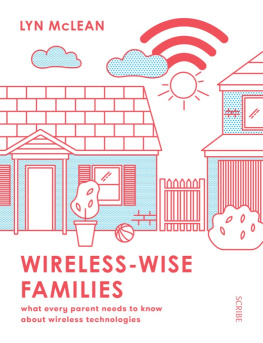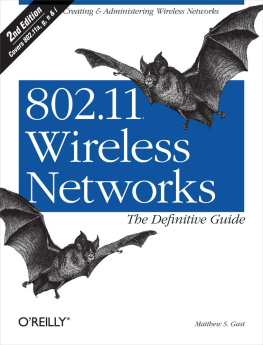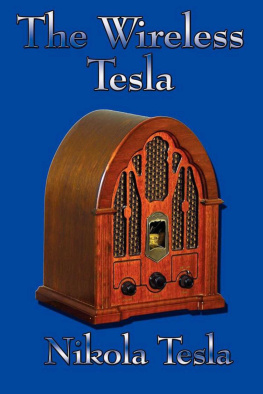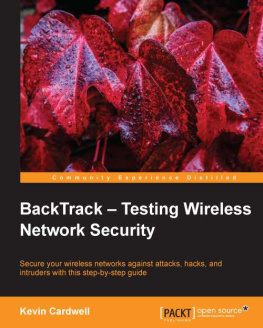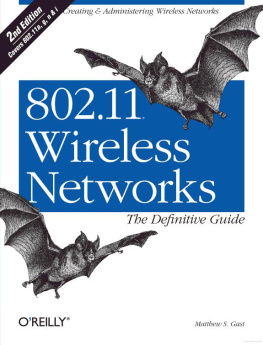Ross - The book of wireless: a painless guide to wi-fi and broadband wireless
Here you can read online Ross - The book of wireless: a painless guide to wi-fi and broadband wireless full text of the book (entire story) in english for free. Download pdf and epub, get meaning, cover and reviews about this ebook. City: San Francisco, year: 2008, publisher: No Starch Press, genre: Business. Description of the work, (preface) as well as reviews are available. Best literature library LitArk.com created for fans of good reading and offers a wide selection of genres:
Romance novel
Science fiction
Adventure
Detective
Science
History
Home and family
Prose
Art
Politics
Computer
Non-fiction
Religion
Business
Children
Humor
Choose a favorite category and find really read worthwhile books. Enjoy immersion in the world of imagination, feel the emotions of the characters or learn something new for yourself, make an fascinating discovery.

The book of wireless: a painless guide to wi-fi and broadband wireless: summary, description and annotation
We offer to read an annotation, description, summary or preface (depends on what the author of the book "The book of wireless: a painless guide to wi-fi and broadband wireless" wrote himself). If you haven't found the necessary information about the book — write in the comments, we will try to find it.
Ross: author's other books
Who wrote The book of wireless: a painless guide to wi-fi and broadband wireless? Find out the surname, the name of the author of the book and a list of all author's works by series.
The book of wireless: a painless guide to wi-fi and broadband wireless — read online for free the complete book (whole text) full work
Below is the text of the book, divided by pages. System saving the place of the last page read, allows you to conveniently read the book "The book of wireless: a painless guide to wi-fi and broadband wireless" online for free, without having to search again every time where you left off. Put a bookmark, and you can go to the page where you finished reading at any time.
Font size:
Interval:
Bookmark:
Copyright 2008

Copyright 2008 by John Ross.
All rights reserved. No part of this work may be reproduced or transmitted in any form or by any means, electronic or mechanical, including photocopying, recording, or by any information storage or retrieval system, without the prior written permission of the copyright owner and the publisher.
Printed on recycled paper in the United States of America
12 11 10 09 08
1 2 3 4 5 6 7 8 9
ISBN-10: 1-59327-169-7
ISBN-13: 978-1-59327-169-5
Publisher: | William Pollock |
Production Editor: | Megan Dunchak |
Cover and Interior Design: | Octopod Studios |
Developmental Editor: | Tyler Ortman |
Technical Reviewer: | Mike Kershaw |
Copyeditor: | Jeanne Hansen |
Compositor: | Riley Hoffman |
Proofreader: | Michael Shorb |
Indexer: | Nancy Guenther |
For information on book distributors or translations, please contact No Starch Press, Inc. directly:
No Starch Press, Inc.
555 De Haro Street, Suite 250, San Francisco, CA 94107
phone: 415.863.9900; fax: 415.863.9950;
Library of Congress Cataloging-in-Publication Data
Ross, John, 1947- The book of wireless : a painless guide to Wi-Fi and broadband wireless / John Ross. --2nd ed. p. cm. Rev. ed. of: Book of Wi-Fi. c2003. Includes index. ISBN-13: 978-1-59327-169-5 ISBN-10: 1-59327-169-7 1. Wireless LANs--Installation. 2. Wireless LANs--Standards. 3. IEEE 802.11 (Standard) I. Ross,John, 1947- Book of Wi-Fi. II. Title.TK5105.78.R67 2008004.6'8--dc22 2007048461No Starch Press and the No Starch Press logo are registered trademarks of No Starch Press, Inc. Other product and company names mentioned herein may be the trademarks of their respective owners. Rather than use a trademark symbol with every occurrence of a trademarked name, we are using the names only in an editorial fashion and to the benefit of the trademark owner, with no intention of infringement of the trademark.
The information in this book is distributed on an "As Is" basis, without warranty. While every precaution has been taken in the preparation of this work, neither the author nor No Starch Press, Inc. shall have any liability to any person or entity with respect to any loss or damage caused or alleged to be caused directly or indirectly by the information contained in it.
I'm grateful to everybody at No Starch Press for their help and advice as this book moved from idea to print. In particular, Tyler Ortman, Megan Dunchak, Michael Kershaw, and Riley Hoffman have made this a much better book than it would have been without their attention. Any remaining faults in the book are, of course, my responsibility.
Thanks also to Georgia Taylor at Verizon Wireless and Helen Chung at Clearwire, who allowed me to borrow equipment and use their networks, and to all the manufacturers and software developers who allowed us to use photographs of their hardware and software.

This is a book for people who want to use the Internet everywherenot just in the office or in the room at home where there's a telephone or cable connection, but in the backyard, at the public library, at a highway rest area, or in a hotel lobby. In this book you will learn how to choose the best wireless data service for your particular needs, how to set up your computer for wireless, and how to design and install your own wireless network. We'll also describe some wireless products and services that you might not have known about, such as the ability to make low-cost, worldwide Voice over Internet (VoIP) telephone calls from your laptop computer.
The combination of wireless Internet services and portable computers can make a huge difference in the way we use the Internet. By eliminating the tether to a wired network, we can gather information, watch and listen to streaming video or audio, and exchange messages wherever we might be, rather than only at specific locations. It's no longer necessary to return home or to the office or search for an Internet caf or a public library. Like mobile telephones (which use related technology), go-anywhere, always-accessible Internet services can change the way we live, work, and entertain ourselves. When wireless broadband Internet services work properly, they're practically invisible; just turn on the computer or a smaller portable device such as a smartphone, and a universe of information is immediately at your fingertips. But we're talking about computers, so complications are always possible. In order to help you identify the causes and solutions for wireless connection problems, the first few chapters of this book offer details about how wireless data communication systems work, including the surprising tale of the avant-garde composer and the glamorous actress whose wartime invention provided the foundation of modern spread-spectrum technology.
As you read this book, I hope you will remember that a wireless network, and for that matter, any kind of communications technology, is a means to an end that you use to achieve some other objective. Remember that your original goal was to find out if your favorite team won, invite your friends to a dinner party, read your class notes, or watch the latest YouTube videos. If you have to concentrate on making your wireless connection, you're doing something wrong.
You're in control. The computer and the network should do things the way you want to do them, rather than forcing you to adjust your life or work to meet the machine's requirements. If you have trouble making your wireless connection (or any other computer activity) work "properly," it's almost always the computer's fault, or the fault of the people who designed the hardware and software. The computer and the network are your servants, and not the other way around.
New wireless network products and services are appearing all the time, so the information in this book represents a snapshot of a moving target. Within another year or two, manufacturers will have replaced some of the products described here with new and better models, and the wireless service providers will offer faster connections over wider areas. The specific makes and models will change, but the general principles ought to remain.
The first edition of this book, The Book of Wi-Fi , was limited to 802.11b Wi-Fi networks, which were the only practical choice when that book was published in 2003. When I wrote that book, I expected Wi-Fi networks to replace or supplement wired home and office networks, but I did not anticipate that a huge number of additional Wi-Fi hot spots would also cover public locations. In my Seattle neighborhood, I can connect my laptop computer to the Internet at a branch library, half a dozen coffee shops, three taverns, four pizza joints, and a supermarket. Today, Wi-Fi signals are everywhere, and other broadband services offer wireless signals that cover much wider areas than any Wi-Fi network. A few years from now, more and better wireless services will offer even faster connections. The dream of a high-speed wireless service that works almost everywhere is rapidly coming true.
Font size:
Interval:
Bookmark:
Similar books «The book of wireless: a painless guide to wi-fi and broadband wireless»
Look at similar books to The book of wireless: a painless guide to wi-fi and broadband wireless. We have selected literature similar in name and meaning in the hope of providing readers with more options to find new, interesting, not yet read works.
Discussion, reviews of the book The book of wireless: a painless guide to wi-fi and broadband wireless and just readers' own opinions. Leave your comments, write what you think about the work, its meaning or the main characters. Specify what exactly you liked and what you didn't like, and why you think so.








